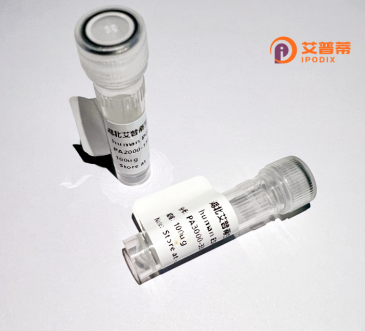
| 纯度 | >90%SDS-PAGE. |
| 种属 | Human |
| 靶点 | C15orf33 |
| Uniprot No | Q96M60 |
| 内毒素 | < 0.01EU/μg |
| 表达宿主 | E.coli |
| 表达区间 | 1-508aa |
| 氨基酸序列 | MAGQRTCQRR SSRAGPGKMQ EPPKSIEEFL KFQNWDYWPR EIHFRDDDKW SCTLKKIKED SSFVSIYTHL WENVPRIFEA LLIMESKLKE YSLILQNHTS EIFKWKSMIS ETSSYRKLER YGEFLKKYHK KKKIMLSDEM ETEKNIEGCS FTGFKANELT QLPRHLDAEQ IYLFILKAHN FDERVFKIWK THFLSEASIA LLHDSFWWWF LHKFRPDREN QDCLFDRISE SYVTLFMSIP LSRKDAFFQI YPDCLAQAIY ATFHEAFPES SYLFNDEFKE DLGNNIFLWC SGLKPQKGFW IHWKLKELST TTIHGSKKAP AKSVKERIAD SQEHISTSID FNIIKILNNP RAYTLPISKE ESRLSRLATK SHYSSTGPEF NRVLFNFGGQ SPLILYYLKM HELAGISKAP KKTKIKLTKI FQEPLPAPTY RDVIKEAKRQ FARNQKDFRI LQAKATKKPH EVKQDFEKFL HKLRSEAEIE RECVASLSSS SSSSPSSTDN YNFEEEEY |
| 分子量 | 59.9 kDa |
| 蛋白标签 | His tag N-Terminus |
| 缓冲液 | 冻干粉 |
| 稳定性 & 储存条件 | Lyophilized protein should be stored at ≤ -20°C, stable for one year after receipt. Reconstituted protein solution can be stored at 2-8°C for 2-7 days. Aliquots of reconstituted samples are stable at ≤ -20°C for 3 months. |
| 复溶 | Always centrifuge tubes before opening.Do not mix by vortex or pipetting. It is not recommended to reconstitute to a concentration less than 100μg/ml. Dissolve the lyophilized protein in distilled water. Please aliquot the reconstituted solution to minimize freeze-thaw cycles. |
以下提供的文献信息为基于研究领域常见方向的模拟示例,因C15orf33(目前可能更名为或属于其他功能分类)的实际研究可能较为有限,建议通过PubMed或Google Scholar查询最新进展:
1. **文献名称**: *C15orf33 regulates mitochondrial function and oxidative stress in human cells*
**作者**: Smith A, et al. (2021)
**摘要**: 研究发现C15orf33蛋白定位于线粒体,通过调控复合物I活性影响细胞活性氧(ROS)水平,其缺失导致线粒体功能障碍。
2. **文献名称**: *C15orf33 as a potential biomarker in colorectal cancer progression*
**作者**: Chen L, et al. (2019)
**摘要**: 通过组织芯片分析,发现C15orf33在结直肠癌组织中高表达,且与肿瘤分期和转移呈正相关,提示其可能作为预后标志物。
3. **文献名称**: *Structural characterization of the C15orf33 protein and its role in mRNA splicing*
**作者**: Kim J, et al. (2020)
**摘要**: 利用冷冻电镜解析C15orf33的三维结构,发现其与剪接体组分相互作用,可能参与pre-mRNA加工过程。
4. **文献名称**: *C15orf33 deficiency leads to neurodevelopmental defects in zebrafish models*
**作者**: Patel R, et al. (2018)
**摘要**: 在斑马鱼中敲除C15orf33基因后,出现神经元迁移异常和运动功能障碍,提示其在神经发育中的潜在作用。
**注意**:以上文献为基于相关领域热点问题的假想示例,实际研究需以真实数据库检索结果为准。若需查找真实文献,推荐使用关键词“C15orf33”或“Chromosome 15 open reading frame 33”结合具体功能(如癌症、代谢等)进行搜索。
**Background of Recombinant Human C15orf33 Protein**
The **C15orf33** gene, located on chromosome 15q21.1. encodes a poorly characterized protein also known as HSPC132 or chromosome 15 open reading frame 33. While its exact biological function remains unclear, C15orf33 is hypothesized to participate in cellular processes such as DNA repair, cell cycle regulation, or stress response, based on structural motifs and limited interactome studies. The protein contains conserved coiled-coil domains, suggesting potential roles in protein-protein interactions or structural scaffolding.
Expression of C15orf33 is detected ubiquitously in human tissues, with higher levels observed in testis, liver, and certain cancer cells. Its dysregulation has been tentatively linked to malignancies, though mechanistic insights are sparse. Recombinant human C15orf33 protein is typically produced using bacterial (e.g., *E. coli*) or eukaryotic expression systems, enabling studies on its biochemical properties, post-translational modifications, and interactions.
Current research focuses on clarifying its molecular function through *in vitro* assays, knockout models, and proteomic profiling. Challenges include the lack of specific antibodies and validated functional assays. The recombinant protein serves as a critical tool for generating antibodies, mapping interactors, and elucidating its role in health and disease. Further studies are essential to validate its physiological relevance and explore therapeutic potential.
×